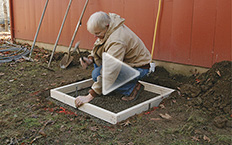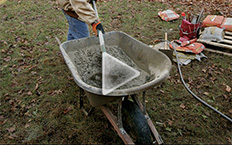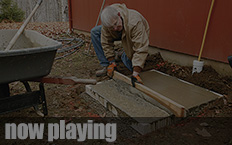How to Pour and Finish a Small Concrete Slab
All you need are a few simple tools and a basic understanding of how concrete works to get beautiful results on any slab.
There are lots of reasons you might need to create a small pad out of concrete—maybe for an air conditioning compressor, a propane tank, a foundation for deck stairs, or even a pool pump and filter. Whatever you need yours for, watch builder and Fine Homebuilding senior editor Andy Engel demonstrate the right techniques to get a nicely finished slab, from settling and leveling the wet mix into the forms to tamping down the aggregate and using the proper tools for finishing.
Videos in this series
 |
Part 1: Forming a Small Concrete Slab
Get the base right and the rest is easy |
 |
Part 2: Hand Mixing Concrete
Mixing concrete with a hoe in a wheelbarrow is simple and fast |
 |
Part 3: Placing and Finishing a Small Slab
Tamp down the aggregate in the mix to make a surface that’s easy to finish |
More about building with concrete:
How to Finish a Concrete Patio Slab — Concrete can be finished in one of several ways. Here, Mike Guertin discusses several approaches, including brushing, troweling, and edging.
Reducing the Risk of Cracks in Concrete Slabs — Whether the slab is free-standing or tied into an existing structure, taking a few precautions will help prevent problems later.
Pouring Concrete Slabs — This is how a truckload of wet concrete is transformed into a smooth, flat slab. Less than ideal weather coming up? There are ways to handle that, too.
Fixing Concrete Cracks: Basement Slab Repair — Cracks in concrete basement slabs aren’t uncommon. Matt Risinger explains how to fix cosmetic defects with a two-part filler called RS-88.
Placing a Small Concrete Slab— Although the amount of concrete that’s required is small, a landing for a deck stairway or, in this case, a pad for a propane tank requires nearly the same forming and finishing techniques as a full-size slab






View Comments
Thanks for another great One Minute video. Well done.
Good technical info. A few suggestions: (1) Background music is too loud - it distracts from the content. (2) Dust mask is a great idea when dealing with dry concrete. The worked had gloves on, but we couldn't see if he was masked.
Great video, short and sweet, but very informative.
Thanks,
TN_P_ELM
Great video! Thank you. I noticed there was no rebar steel in the form. I was taught to put rebar in about every 12" depending on the intended load on the slab. Why wasn't any regard used in this video?
Brianrussel, rebar seemed like overkill for a 3 x 3 non-structural slab.
Just a thought and another
Two choices... Either lay some this plastic on the inner side of your wooden frame ...
or
Spray some WD 40 type oil base on the same inside of the frame...
Doing so, prevents the concrete/ cement from adhering to the wood frame so it is easier to remove and........................................ gives the outside edge of your base a neat clean look.